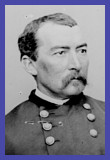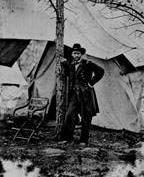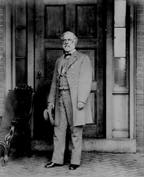
|

|
 Ulysses S. Grant
Ulysses S. Grant
|
On
February 29, 1864, Ulysses S. Grant was appointed General-in-Chief of the
Union Army, and the war is starting over. As soon as Grant received
the news, he met with General Sherman. Grant’s plan was that Sherman
would go after Joe Johnston while he would go after Robert E. Lee, the
General of the Confederates. Grant once said: “The art of war is simple
enough. Find out where your enemy is. Get at him as soon as you can. Strike
at him as hard as you can and as often as you can, and keep moving on.”
Grant’s strategy was different from all the others. He believed the Union
should focus on the Confederate army and not the Confederate capital. |
|
| As
Grant marched passed the Ripidan River he met Lee in Virginia in the battle
called The Wilderness. After two days of
long fighting Lee was able to stop Grant's offensive charge, but Grant
decided to slip out and move south. The total killed was 2,246, and
it didn't matter to Grant and the Union Army moved on. Grant and
Lee meet again at Spotsylvania. During the first phase Colonel Upton, a
Union commander, tried to penetrate the Confederates, but failed.
Grant was attempting to find the flanks of the Confederates. Lee stopped
him again. Union Losses were huge 14,267. Once again it didn't stop the
Union from moving on. |
| Philip
Sheridan, a Union commander, was just a little south of Grant fighting
in the battle of Yellow Tavern. Sheridan
opponent was J.E.B. Stuart. The North was able to claim victory because
Stuart was wounded and could not continue. On May 23rd Grant arrived
at Totpotomy Creek and Lee wasted no time in attacking. However, Grant
was able to escape and move south. |
 Philip Sheridan
Philip Sheridan
|
|
| The
fourth battle began at Cold Harbor. Grants
army was reinforced to 100,000 men. Grant ordered several assaults; the
Confederates stopped all. In one hour, Grant had lost 7,000 men.
The Union retreated and moved south. The Union's total losses were
13,078. |
| Sheridan
teamed up with Grant to cause confusion within the Confederates. No side
was able to claim victory. |
| Crossing
the James was the final battle of the Overland Campaign. Grant got
help from the Navy and moved Lee in place to take over Petersburg. |
| Grant's
strategy confused the south. No other commander kept going except Grant.
The Overland Campaign was very successful it led the Union into Petersburg
and to take over Richmond. Grant's strategy of not retreating worked
and he led the Union to claim victory. |
|
|
|
View Overland
Campaign Map
|
  
Grant
Lee
|
| |
|
|
BIBLIOGRAPHY
|
| Candace Scott "Ulysses S. Grant
Home Page", Jan. 1, 1999http://www.mscomm.com/~ulysses/
(30 Oct. 2000). |
|
| Geoffrey C. Ward, "The Civil War",
Alfred A. Knopf, Inc., 1990 |
|
| William Loren Katz, "An Album of
the Civil War", Franklin Watts, Inc., 1974 |
|
|
| Brett Eakin |
|






